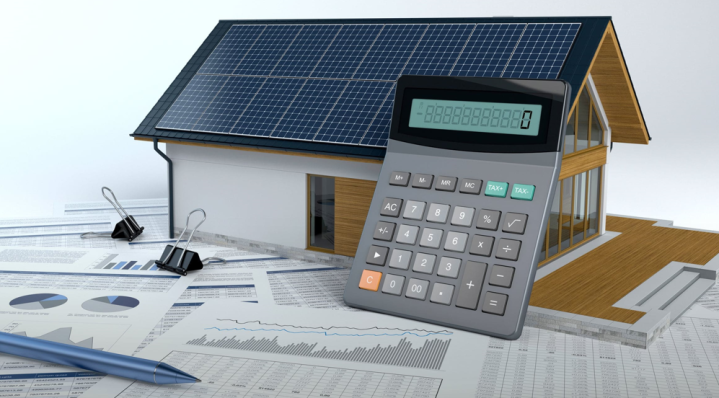SPONSORED CONTENT
Your Guide to Solar Financing

Load shedding quintupled last year compared to 2021, when measured in Gigawatt hours. An alarming statistic if there ever was one! To explain, gigawatt hours is a measurement of the volume of electricity that is load shed. When there is 1 hour of stage 1 load shedding, we experience 1 Gigawatt hour of load shedding. However when there is 1 hour of stage 6 load shedding, we experience 6 Gigawatt hours of load shed.

That is just looking at how load shedding has gone up until the end of last year. If we were to make an analogy about the amount of load shedding experienced over the last few years. We could say that in 2019 we had loadshedding that was at the flying altitude of a small duo passenger plane. In 2021 we had load shedding at the altitude of a Boeing 747, and last year we broke through the lower part of the atmosphere. Looking at how load shedding has gone this year, the picture unfortunately gets even worse.

By the 31st of March, we have already experienced three quarters of the load shedding that took place last year. If last year we went like a rocketship into the lower atmosphere, this year we are going like an Elon Musk Starship. We really are in uncharted territory in South Africa when it comes to the escalation of load shedding over the last year.
With all the recent revelations regarding the energy sector and a myriad of contributory factors indicating that load shedding will only further increase in the short and medium term. A conservative projection for loadshedding is that it will double over the next 5 years, from the base of 2022.

The main contribution to this load shedding is that there will be no publicly funded large scale generation capacity coming online for the foreseeable future, which is what is needed to meet the peak demand that occurs in the late evenings and early mornings. What is interesting to note is that this load shedding will occur over not just one general election cycle, but two. With load shedding projected to still be with us for the next 10 years as outlined recently by the CSIR. A recent study confirmed that grid constraints are hindering new wind power coming online in the South of the country that could power the demand in the North of the country. What is clear is that going forward, we will not be able to rely on Eskom to meet our electricity needs, both as individuals and as a nation.
Sign up to generate your customised Hohm Energy solar proposal within 3 minutes
What is the solution?
With all this load shedding taking place, the chances are you’ve considered what your options are when it comes to generating your own power. Rooftop solar is, by some distance, the most effective way of doing so.
Not only does it allow you to produce power in a way that’s good for the environment (something that can’t be said of diesel generators), it also allows you to do so in a modular way. That means that you can start with power and battery backup for your most essential electrical needs and expand later on. Additionally, with the rest of the country looking like it will follow Cape Town’s example, you will also get paid for feeding back into the grid in the near future.
Of course, even with the tax incentives announced during the most recent budget speech, installing rooftop solar, out of pocket, requires a significant capital outlay and unless you’re fortunate enough to be able to pay for your installation outright, you’re going to have to finance it. It can, however, be all too easy for people to get lost in the financing options available to them.
Fortunately, it doesn’t have to be that way. We’ve outlined the basics of the solar financing options available to you right now, allowing you to better choose the right solar financing option for your home.
Sign up to generate your customised Hohm Energy solar proposal within 3 minutes
Dedicated solar financing
Fortunately, a growing number of South African financial institutions now offer dedicated solar financing options. These offerings are typically the best option for anyone who wants to own their solar system outright and who wants to get their financing and installation done as quickly as possible. At Hohm Energy, we’re big fans of Nedbank Motor Finance Corporation’s (MFC) asset solar financing product. That’s not just because we were the first to offer this as their exclusive partner, but also because we believe it really is the best option.
With the financing being organised through MFC, anyone who’s ever financed a car should be familiar with how it works. Essentially, you would gather the documentation required for the application and, once you’re approved, the loan amount is paid over to Hohm Energy for us to supply and install your system, whereafter you have six years to pay it off.
While you’ll likely end up having to pay off a little more each month than you would if you extended your home loan, you’ll have paid it off in six years (just like with your car). As such all the savings and anything you get from feed-in-tariffs thereafter go straight into your pocket.
Extend your home loan
Another option is to extend your home loan to accommodate the cost of a solar system and installation. Because of the comparatively low interest rates of home loans, this can be the most cost-effective option. But again, there are downsides. For example, South African financial regulations mean that you can only extend your bond after paying it off for five years. Given that the average South African moves house every seven years, that means it’s simply not an option for many South African homeowners.
As anyone who’s had to try and play catch-up on their own home loan over the past few months will also tell you, rising interest rates mean that taking this option might leave you paying a lot more than you initially thought you would be. Extending your bond in this way is also a complex administrative process, meaning that it could take up to 3 months or longer before you have a functioning solar system.
Sign up to generate your customised Hohm Energy solar proposal within 3 minutes
Rent-to-own
The rent-to-own model is hardly unfamiliar to most South Africans. Teljoy, one of the country’s most iconic brands, has used it to sell appliances for decades. Essentially, rent-to-own means that the company you’re renting from owns your solar system until you’ve paid it off. That comes with several advantages, especially if the company maintains your installation throughout the payment period.
There are, however, disadvantages too. If, for example, you need to move somewhere else before you’ve paid the system off and are unable to take it with you, then the company can take the system back and you’ll have nothing to show for the money that you’ve spent. In the long term, you may also see lower savings returns than if you’d bought the system outright.
It is highly recommended that you read the rental contract conditions and pay particular attention to the buy-out clauses and separation clauses. Some companies that offer evergreen rental contracts stipulate that you need to pay double the purchase price of your system if you want to pay off your system and the earliest you can pay it off is after a few years. In addition, if you want to cancel your contract, there is a separation fee of up to 1/5th of the cost of the system, which could be considered as onerous contractual conditions.
Sign up to generate your customised Hohm Energy solar proposal within 3 minutes
Personal loan
Probably the least attractive option, a personal loan means going to your bank or any other lender, applying for a loan and using the money to pay for the installation. Given that personal loans tend to attract some of the highest possible interest rates, this should probably be your last option.
Here is a summary of the options available for solar system financing:

Know your needs
Ultimately, as with anything that needs financing, the route you ultimately take shouldn’t be chosen lightly and should be well researched. Solar systems are a big investment and the finance industry has become very innovative to support a number of different finance solutions. If you are considering not purchasing your solar system upfront, you have the following range of options to choose from.
But if you work with experts to establish exactly what your solar and affordability needs are, then you’ll be in a much better position to make the right choice.
Check out Hohmenergy.co.za to see how you can be assisted in taking care of your own energy needs. DM
















